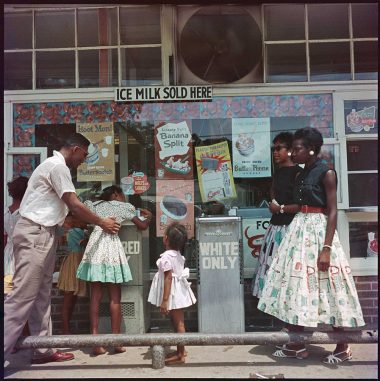Exhibition Dates: August 2 – September 20, 2014
Opening Reception: Saturday, August 2 from 6–9 pm, in conjunction with White Linen Night
Gallery Location: 434 Julia Street, New Orleans, LA 70130
Hours: Tuesday–Saturday, 10 am–5 pm
Contact Info: 504.522.1999; www.arthurrogergallery.com
The Arthur Roger Gallery is pleased to present Segregation Story, an exhibition of photographs by Gordon Parks. The exhibition will be on view at Arthur Roger@434, located at 434 Julia Street, from August 2 – September 20, 2014. The gallery will host an opening reception on Saturday, August 2 from 6-9 pm in conjunction with White Linen Night.

At Segregated Drinking Fountain, Mobile, Alabama, 1956, 2013. Archival pigment print. 28 x 28 inches.
© The Gordon Parks Foundation
Gordon Parks is considered one of the most influential American photographers of the postwar years and was the first African-American to work as a staff photographer for Life magazine. He is best remembered for his photographic essays that chronicled the social and economic impact of racism.
This exhibition of fifteen medium-scale photographs includes never-before-published images originally part of a series photographed for a 1956 Life magazine photo-essay assignment, “The Restraints: Open and Hidden.” In it, Parks documented the everyday lives of an extended black family living in rural Alabama under Jim Crow segregation. Powerful images include a woman and her niece beautifully dressed for town, standing below an overt red neon sign reading, “Colored Entrance” at a department store in Mobile, Alabama. Another, Outside Looking In, Mobile, Alabama, 1956, depicts six young children pressed against a chain link fence gazing at a Whites Only playground filled with slides and a Ferris wheel. An older girl stands with her arm gently cradling the younger girl to her left.
This compelling series demonstrated that the ambitions, responsibilities and routines of this family were no different than those of white Americans, thus challenging the myth of racism. Parks often said that his camera was his weapon of choice to fight injustice.
Gordon Parks was born in Kansas in 1912 and later raised in St. Paul, Minnesota. He bought a camera at a young age and taught himself how to use it, eventually leading to a position with the Farm Security Administration (F.S.A.). Following its closure in 1943, he worked as a freelance photographer prior to joining Life Magazine where he remained for two decades. He held over fifty honorary doctorates, was a celebrated composer, author, and filmmaker, and the recipient of the 1988 National Medal of Arts. Gordon Parks died in 2006 at the age of 93.
